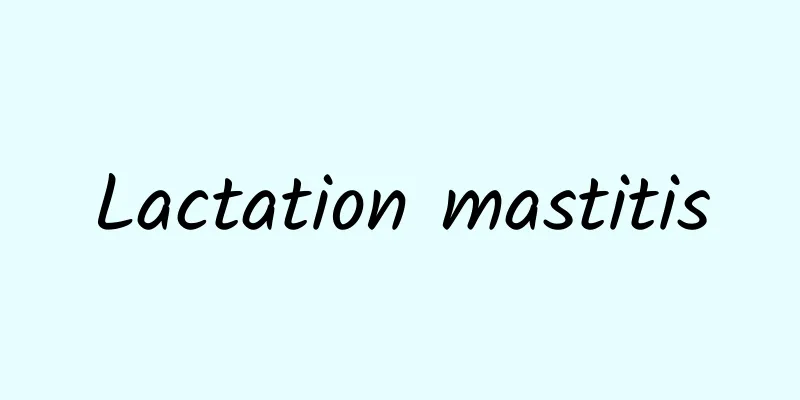Lactation mastitis

|
This is the 3896th article of Da Yi Xiao Hu Lactational mastitis is a common disease among breastfeeding mothers. The WHO defines it as: an inflammatory reaction of the breast caused by milk congestion or infection during lactation, which may or may not be accompanied by bacterial infection, with or without redness, swelling, heat, and pain in the breast area, and may be accompanied by fever, chills, flu-like symptoms, and other general discomfort. Lactational mastitis often occurs in the first two months after delivery. It often recurs, is difficult to heal, and may even develop into breast abscess. There are misunderstandings in the treatment of lactational mastitis, such as the abuse of antibiotics and premature cessation of breastfeeding, which have a certain impact on the physical and mental health of lactating mothers and the growth and development of their children. Causes of mastitis during lactation The main causes of lactation mastitis are milk stasis, nipple rupture leading to bacterial infection and poor body resistance after childbirth. The causes of milk stasis include congenital nipple dysplasia, too little sucking by the baby, excessive milk secretion, fear of pain, and milk stasis caused by excessive lactation. Nipple rupture is mainly caused by improper feeding, baby biting, etc., which form open wounds, allowing bacteria to enter and multiply, leading to lactation mastitis. Poor local hygiene of the nipple is also an important cause. Symptoms of mastitis during lactation Clinically, breastfeeding mastitis is mainly divided into two types: milk stasis type and acute breast inflammation type. The milk stasis type is characterized by local swelling, pain, and induration of the breast, with no obvious increase in skin temperature. Mothers do not have inflammatory symptoms such as fever and chills, and blood routine tests are generally normal. The acute breast inflammation type is characterized by local redness, swelling, heat, and pain of the breast, accompanied by systemic fever, and blood routine tests generally show an increase in white blood cell and neutrophil counts and C-reactive protein. Treatment of mastitis during lactation For lactation mastitis, the main treatment method is auxiliary milk ejection plus antibiotics. For patients with milk stasis, we can use standardized manual milk ejection or electric milk drainage treatment, assisted by local breast medication. For acute inflammation, in addition to milk ejection, antibiotic treatment is required. During the entire treatment period, try to avoid eating to induce lactation, and a light diet is recommended to keep the local nipple clean. Ensure that the mother has adequate rest, and appropriately replenish fluids, use painkillers, and provide psychological counseling. Use of antibiotics The antibiotics that can be used for acute breast inflammation during lactation are penicillin or cephalosporin antibiotics. However, since some of the accumulated antibiotics in the body of lactating women will enter the breast milk, it may affect the number of probiotics in the infant's intestines. When using these two types of antibiotics, the infant should be observed for diarrhea symptoms. If severe diarrhea occurs, breastfeeding should be stopped or other types of antibiotics should be used instead. Antibiotics that are strictly prohibited for use during breastfeeding include tetracycline, ciprofloxacin, and chloramphenicol. Once used, breastfeeding should be stopped immediately. In rare cases, the inflammation involves the entire breast. At this time, milk should be weaned and breastfeeding should be stopped in order to better control the infection. If an abscess is formed, incision or puncture drainage should be considered. If I have mastitis during lactation, can I continue breastfeeding? Regardless of whether it is lactational mastitis, as long as no breast abscess is formed, the patient should be encouraged to continue breastfeeding on the affected side during the treatment process, and feeding on the healthy side will not be affected. Studies have shown that continuing to feed during lactational mastitis will not only not cause health damage to the baby and the mother, but will also help the health of the baby and the mother, because the types and numbers of immune cells and cytokines in the breast milk of patients with lactational mastitis have increased. Such changes not only help the mother's own resistance to breast infection, but also help activate the baby's immune system. If feeding is difficult due to the wound on the breast, or the baby's sucking cannot relieve breast symptoms at all, or there is an excessive worry that continuing to feed will cause the baby to be infected, you can also choose to manually express milk or use a breast pump to express milk to maintain milk secretion. Mastitis during lactation often occurs. Young mothers should face it with a positive and optimistic attitude, identify breast changes in time, seek medical attention as soon as possible, and take appropriate measures. In addition, in the process of treating mastitis during lactation, follow the doctor's instructions and use individualized treatment. This will not only not affect your own health and the health of your baby, but also allow you to continue breastfeeding scientifically while promoting the recovery of your own breasts, avoiding fear of breastfeeding and inappropriate cessation of breastfeeding. Author: Huang Luyao Qian Mingping |
<<: Can anger really make one blind? After a quarrel with someone, she almost went blind...
>>: Lifestyle changes and drug treatment for dyslipidemia
Recommend
Is it normal for pregnant women to have diarrhea every morning?
In the later stages of pregnancy, the mother'...
Urgent! What should I do if I have a lot of dandruff? Dermatologists tell you these tips
Expert of this article: Wang Ruiyan, MD, associat...
Can you fall asleep quickly by eating more carbohydrates before going to bed? Eat this way if you want to sleep well →
"Eating more carbohydrates before going to b...
Can I eat biscuits and bread after a miscarriage?
After a miscarriage, you should pay special atten...
What is The Siamese Code adapted from? Is Luo Yunxi the lead actor in The Siamese Code?
The TV series Siamese Code starring Xie Binbin, L...
With cold fronts arriving one after another, how can we stay healthy during the winter?
As soon as the beginning of winter arrives, cold ...
What does it mean if a woman has a mole above the right corner of her mouth?
Some people seem to have a face full of moles, wh...
How to treat heavy menstrual flow during menopause
If a female friend has problems such as heavy men...
How to deal with peach gum from your own peach tree? How to deal with fresh peach gum so that it can be eaten
If you grew up in the countryside and have plante...
How to deal with the yellowing and falling leaves of gardenias?
Gardenia is very common in life. Many people like...
Can I eat king crab during menstruation?
Many female friends are usually very healthy, but...
Why do you need to take birth control pills after an abortion?
Almost all women who become pregnant unexpectedly...
What are the disadvantages of laparoscopy?
Dear female friends, you must pay attention to se...
Which department should women go to for dizziness
Many diseases are symptoms of dizziness and nause...









